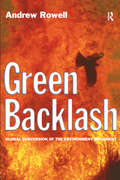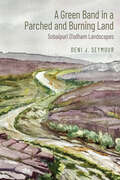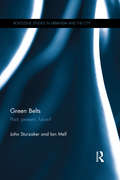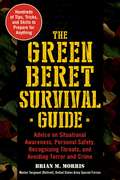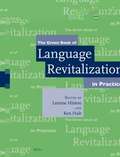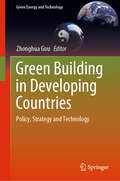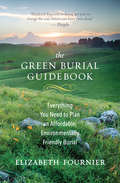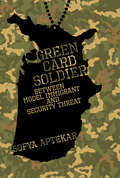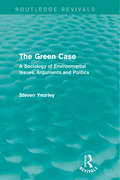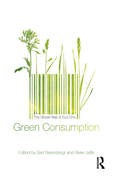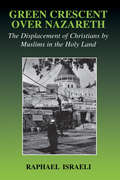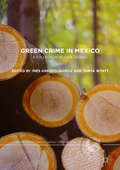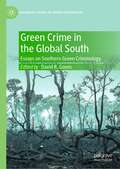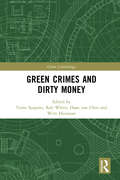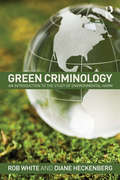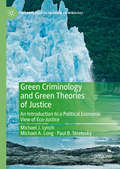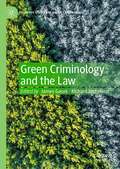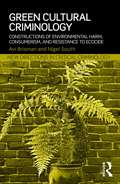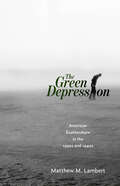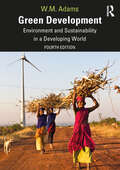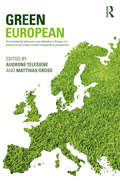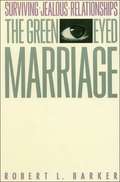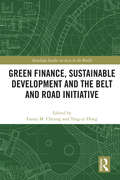- Table View
- List View
Green Backlash: Global Subversion of the Environment Movement
by Andrew RowellThe tide is turning against environmentalism as the political right, industry and governments fight back. Green Backlash is a controversial expose of the anti-environmental movement. Tracing the rise of the backlash from the Wise Use movement in the USA, the author reveals its rapid spread worldwide: the anti-roads movement in the UK, forestry debates in Canada and Australia, marine resource issues in Europe, South-East Asia, and controversies such as the Brent Spar. The backlash is set to get worse as the resource wars intensify. This book offers a greater understanding of the challenges and threats facing global environmentalism, concluding that the environmental movement now has a chance to re-evaluate and change for the better to beat the backlash - a chance that must not be missed.
A Green Band in a Parched and Burning Land: Sobaipuri O’odham Landscapes
by Deni J. SeymourThe result of decades of research, A Green Band in a Parched and Burning Land presents a thorough and detailed understanding of the Sobaipuri O’odham—arguably the most influential and powerful Indigenous group in southern Arizona in the terminal prehistoric and early historic periods, yet one of the least understood and under-studied to have occupied the region. Deni J. Seymour combines historical sources with fresh archaeological data and oral history to reveal an astonishingly different view of, and revise conventional wisdom around, the native history of the region. First and foremost irrigation farmers, the Sobaipuri O’odham permanently occupied verdant strips along all the major rivers in the region—including the headwaters of the San Pedro and various other areas thought to be beyond their domain. Seymour draws on career-spanning fieldwork, conversations with direct descendants (the O’odham residents of Wa:k), and recent breakthroughs in archaeological, ethnographic, and ethnohistorical research to shed light on their unique forms of landscape use, settlement patterns, and way of life. She details the building materials, linear site layout, and other elements of their singular archaeological signature; newly established dating for individual sites, complex building episodes, and occupational sequences; and evidence of cumulative village occupation as well as the habitation of river valleys and other locales long after supposed abandonment. The book also explains the key relationships between site distributions and landscape characteristics. Addressing some of the longest-standing archaeological and historical questions about the Sobaipuri O’odham, A Green Band in a Parched and Burning Land reorients the discussion of their crucial place in the history of the region in constructive new directions.
Green Belts: Past; present; future? (Routledge Studies in Urbanism and the City)
by John Sturzaker Ian MellMost of us have heard of green belts – but how much do we really know about them? This book tries to separate the fact from the fiction when it comes to green belts by looking both backwards and forwards. They were introduced in the mid-twentieth century to try and stop cities merging together as they grew. There is little doubt they have been very effective at doing that, but at what cost? Are green belts still the answer to today’s problems of an increasing population and ever higher demands on our natural resources? Green Belts: Past; present; future? reflects upon green belts in the United Kingdom at a time when they have perhaps never been more valued by the public or under more pressure from development. The book begins with a historical study of the development of green belt ideas, policy and practice from the nineteenth century to the present. It discusses the impacts and characteristics of green belts and attempts to reconcile perceptions and reality. By observing examples of green belts and similar policies in other parts of the world, the authors ask what we want green belts to achieve and suggest alternative ways in which that could be done, before looking forward to consider how things might change in the coming years. This book draws together information from a range of sources to present, for the first time, a comprehensive study of green belts in the UK. It reflects upon the gap between perception and reality about green belts, analyses their impacts on rural and urban areas, and questions why they retain such popular support and whether they are still the right solution for the UK and elsewhere. It will be of interest to anyone who is concerned with planning and development and how we can provide the homes, jobs and services we need while protecting our more valuable natural assets.
The Green Beret Survival Guide: Advice on Situational Awareness, Personal Safety, Recognizing Threats, and Avoiding Terror and Crime
by Brian M. MorrisToday's society is one in which we, as individuals, are constantly barraged by the threat of domestic terrorism. The ever-present fear for your safety and the safety of those we love can overwhelm you if you aren’t sure how to protect yourself. Luckily, distinguished combat veteran Brian M. Morris's Green Beret Survival Guide is here to help ease your fears. Using his firsthand knowledge from the field as a Green Beret, Morris concisely outlines the steps that are necessary towards increasing one’s personal safety. Over the course of several chapters, Morris describes the importance of situational awareness, meaning staying alert, being aware of your surroundings, and understanding the reality of threats that you may face in any given situation. An individual with good situational awareness never takes anything for granted and makes security a part of his or her daily routine. By being observant and practicing several different methods of observation, one can avoid falling prey to terrorist, thieves, and other criminals. Using situational awareness as the cornerstone of a personal safety plan, The Green Beret Survival Guide delivers expert advice on preparing you and your loved ones for the worst case scenario.
The Green Book of Language Revitalization in Practice
by Leanne Hinton Kenneth HaleWith world-wide environmental destruction and globalization of economy, a few languages, especially English, are spreading rapidly in use, while thousands of other languages are disappearing, taking with them important cultural, philosophical and environmental knowledge systems and oral literatures. We all stand to suffer from such a loss, none more so than the communities whose very identity is being threatened by the impending death of their languages. In response to this crisis, indigenous communities around the world have begun to develop a myriad of projects to keep their languages alive. This volume is a set of detailed accounts about the kind of work that is going on now as people struggle for their linguistic survival. It also serves as a manual of effective practices in language revitalization. Following are the key features: 23 case studies of language revitalization in practice, from Native American languages, Australian languages, Maori, Hawaiian, Welsh, Irish, and others, written primarily by authors directly involved in the programs; short introductions situate the languages, to help make the languages more 'real' in the minds of readers; each chapter gives a detailed overview of the various kinds of programs and methods in practice today; introductions and maps for each of the languages represented familiarize the reader with their history, linguistic structure and sociolinguistic features; and, strong representation in authorship and viewpoint of the people and communities whose languages are threatened, gives the readers an inside understanding of the issues involved and the community-internal attitudes toward language loss and revitalization. This book was previously published by Academic Press under ISBN 978-01-23-49354-5.
Green Building in Developing Countries: Policy, Strategy and Technology (Green Energy and Technology)
by Zhonghua GouThe book reveals how green buildings are currently being adapted and applied in developing countries. It includes the major developing countries such as China, Indonesia, Malaysia, Thailand, Pakistan, Cambodia, Ghana, Nigeria and countries from the Middle East and gathers the insights of respected green building researchers from these areas to map out the developing world’s green building revolution. The book highlights these countries’ contribution to tackling climate change, emphasising the green building benefits and the research behind them.The contributing authors explore how the green building revolution has spread to developing countries and how national governments have initiated their own green building policies and agendas. They also explore how the market has echoed the green building policy, and how a business case for green buildings has been established. In turn, they show how an international set of green building standards, in the form of various techniques and tools, has been incorporated into local building and construction practices. In closing, they demonstrate how the developing world is emerging as a key player for addressing the energy and environmental problems currently facing the world.The book helps developers, designers and policy-makers in governments and green building stakeholders to make better decisions on the basis of global and local conditions. It is also of interest to engineers, designers, facility managers and researchers, as it provides a holistic picture of how the industry is responding to the worldwide call for greener and more sustainable buildings.
The Green Burial Guidebook: Everything You Need to Plan an Affordable, Environmentally Friendly Burial
by Elizabeth FournierFuneral expenses in the United States average more than $10,000. And every year conventional funerals bury millions of tons of wood, concrete, and metals, as well as millions of gallons of carcinogenic embalming fluid. There is a better way, and Elizabeth Fournier, affectionately dubbed the “Green Reaper,” walks you through it, step-by-step. She provides comprehensive and compassionate guidance, covering everything from green burial planning and home funeral basics to legal guidelines and outside-the-box options, such as burials at sea. Fournier points the way to green burial practices that consider both the environmental well-being of the planet and the economic well-being of loved ones.
Green Card Soldier: Between Model Immigrant and Security Threat (Labor and Technology)
by Sofya AptekarAn in-depth and troubling look at a little-known group of immigrants—non-citizen soldiers who enlist in the US military.While the popular image of the US military is one of citizen soldiers protecting their country, the reality is that nearly 5 percent of all first-time military recruits are noncitizens. Their reasons for enlisting are myriad, but many are motivated by the hope of gaining citizenship in return for their service. In Green Card Soldier, Sofya Aptekar talks to more than seventy noncitizen soldiers from twenty-three countries, including some who were displaced by conflict after the US military entered their homeland. She identifies a disturbing pattern: the US military&’s intervention in foreign countries drives migration, which in turn supplies the military with a cheap and desperate labor pool—thereby perpetuating the cycle.As Aptekar discovers, serving in the US military is no guarantee against deportation, and yet the promise of citizenship and the threat of deportation are the carrot and stick used to discipline noncitizen soldiers. Viewed at various times as security threats and members of a model minority, immigrant soldiers sometimes face intense discrimination from their native-born colleagues and superiors. Their stories—stitched through with colonial legacies, white supremacy, exploitation, and patriarchy—show how the tensions between deservingness and suspicion shape their enlistment, service, and identities. Giving voice to this little-heard group of immigrants, Green Card Soldier shines a cold light on the complex workings of US empire, globalized militarism, and citizenship.
The Green Case: A Sociology of Environmental Issues, Arguments and Politics (Routledge Revivals)
by Steven YearleyFirst published in 1991, this title provides a comprehensive and objective account of the basis of ‘green’ arguments and their social and political implications. By the beginning of the 1990s, environmental awareness had become widespread, popular, and fashionable throughout the West, adopted by politicians, manufacturers and advertising agencies. The book sets out to explain why and how the ‘green wave’ developed, and examines the forces still shaping green politics and policies at an international level. With important implications across the fields of Sociology, Development Studies and Environment and Sustainability, this reissue will be valuable to a broad student and academic readership.
Green China: Seeking Ecological Alternatives
by Geoffrey Murray Ian G. CookDrawing on a wide range of Chinese and western sources, this book offers in-depth analysis of the complete range of environmental problems facing China today, from the historical, political, economic and cultural root causes, through the successful and unsuccessful efforts which have been made to find solutions, to possible future scenarios and strategies.
Green Consumption: The Global Rise of Eco-Chic (Criminal Practice Ser.)
by Bart BarendregtGreen lifestyles and ethical consumption have become increasingly popular strategies in moving towards environmentally-friendly societies and combating global poverty. Where previously environmentalists saw excess consumption as central to the problem, green consumerism now places consumption at the heart of the solution. However, ethical and sustainable consumption are also important forms of central to the creation and maintenance of class distinction. Green Consumption scrutinizes the emergent phenomenon of what this book terms eco-chic: a combination of lifestyle politics, environmentalism, spirituality, beauty and health. Eco-chic connects ethical, sustainable and elite consumption. It is increasingly part of the identity kit of certain sections of society, who seek to combine taste and style with care for personal wellness and the environment. This book deals with eco-chic as a set of activities, an ideological framework and a popular marketing strategy, offering a critical examination of its manifestations in both the global North and South. The diverse case studies presented in this book range from Basque sheep cheese production and Ghanaian Afro-chic hairstyles to Asian tropical spa culture and Dutch fair-trade jewellery initiatives. The authors assess the ways in which eco-chic, with its apparent paradox of consumption and idealism, can make a genuine contribution to solving some of the most pressing problems of our time.
Green Crescent Over Nazareth: The Displacement of Christians by Muslims in the Holy Land (Israeli History, Politics and Society)
by Raphael IsraeliThis is the story of the cultural and political struggle between Christians and Muslims, and of the rapid Islamicization of Nazareth - the birthplace of Christianity - ironically, under the rule of the Jewish State of Israel.
Green Crime in Mexico: A Collection Of Case Studies (Palgrave Studies In Green Criminology Ser.)
by Tanya Wyatt Ines Arroyo-QuirozThis collection is the first exploration into green crime in Mexico, offering a unique critique of the environmental problems facing Mexico today. Written by a diverse range of Mexican academics and practitioners from different career stages and various different disciplines, this edited volume exposes the corruption, power, and disregard for the environment through highly detailed and engaging case studies. The chapters are grouped into four categories: Environmental Degradation, Social and Environmental Justice, Wildlife Trafficking, and Non-compliance with Environmental Obligations, and are illuminated by rigorous original research. This book fills a substantial gap in knowledge about concerns that are important not only to the Mexican people and the wider region, but to anyone with an interest in the environmental issues facing the world today. To this end, the contributors hope to inspire other Mexicans to study and research green crimes as well as to influence scholars and practitioners across Central and South America who are facing similar environmental crises and challenges.
Green Crime in the Global South: Essays on Southern Green Criminology (Palgrave Studies in Green Criminology)
by David R. GoyesThis book presents a socio-criminological study of environmental crime in the global South. It gathers contributors from all the regions of the geographical global South (Africa, Asia, Oceania, and Latin America) to discuss instances of environmental crime and conflict. Overall, it seeks to further decolonise the knowledge production of green criminology. It considers the legacy of colonisation, North-South and the core-periphery divides in the production of environmental crime, the epistemological contributions of the marginalised, impoverished, and oppressed, and the unique contexts of the global South. This book has three sections: drivers of green crime in the global South; responses to environmental harm in the global South; and global dialogues about crime and destruction in the global South. The first two sections represent the breadth of the topics that green criminologists have historically studied but from unique perspectives. The third section explores ethical and decolonial ways for Southern green criminology to collaborate with Western academia. This book speaks to scholars in criminology, political ecology, decolonial theory, along with the many readers interested in the interactions between humans and nature.
Green Crimes and Dirty Money (Green Criminology)
by Toine Spapens, Rob White, Daan van Uhm and Wim HuismanEnvironmental crimes are primarily driven by financial motives. The combined financial value of illicit trade in protected wildlife, illegal logging and waste trafficking is estimated to come directly after counterfeiting, the narcotic drugs trade and illegal gambling. Logically, the proceeds of these crimes must also be laundered. Goods, however, are not the only money maker for environmental criminals. Corporations may also try to ‘save’ costs by not complying with environmental regulations and thus commit crimes of omission rather than commission. From an enforcement and compliance perspective focusing on the proceeds of crime may therefore be an effective strategy. This book brings together different perspectives on the financial aspects of environmental crime and harm from a green criminological viewpoint. It addresses the role of economic systems, the value of environmental performance for corporations, money laundering in the context of environmental crime, financial investigation and questions of regulation and penalties. Discussing these topics from the view of green criminology, sociology and governance, this book will be of great interest to all those concerned about the financial dimensions of crime and the environment.
Green Criminology: Crime, Justice, and the Environment
by Michael J. LynchThis groundbreaking text provides students with an overview and assessment of green criminology as well as a call to action. Green Criminology draws attention to the ways in which the political-economic organization of capitalism causes ecological destruction and disorganization. Focusing on real-world issues of green crime and environmental justice, chapters examine ecological withdrawals, ecological additions, toxic towns, wildlife poaching and trafficking, environmental laws, and nongovernmental environmental organizations. The book also presents an unintimidating introduction to research from the physical sciences on issues such as climate change, pollution levels, and the ecological footprint of humans, providing a truly interdisciplinary foundation for green criminological analysis. To help students succeed in the course—and to encourage them to see themselves as future green criminology researchers—the end-of-chapter study guides include: • Questions and Activities for Students that review topics students should be able to conceptualize and address.• Lessons for Researchers that suggest additional areas of research in the study of green crime.
Green Criminology: An Introduction to the Study of Environmental Harm
by Rob White Diane HeckenbergOver the past ten years, the study of environmental harm and ‘crimes against nature’ has become an increasingly popular area of research amongst criminologists. This book represents the first international, comprehensive and introductory text for green criminology, offering a concise exposition of theory and concepts and providing extensive geographical coverage, diversity and depth to the many issues pertaining to environmental harm and crime.Divided into three sections, the book draws on a range of international case studies and examples, and looks at the conceptual and methodological foundations of green criminology, before examining in detail areas of environmental crime and harm, and how they are addressed, including: climate change and social conflict; abuse and harm to animals; threats to bio-diversity; pollution and toxic waste; environmental victims; environmental regulation, law enforcement and courts; environmental forensic studies; environmental crime prevention. Green Criminology is packed with pedagogical features, including dialogue boxes, case examples, discussion questions and lists of further reading and is perfect for students around the world engaged with green criminology and crime against the environment.
Green Criminology and Green Theories of Justice: An Introduction to a Political Economic View of Eco-Justice (Palgrave Studies in Green Criminology)
by Michael J. Lynch Michael A. Long Paul B. StreteskyThis book offers an alternative analysis of the various theories and dimensions of green and environmental justice which are rooted in political economy. Much green criminological literature sidelines political economic theoretical insights and therefore with this work the authors enrich the field by vigorously exploring such perspectives. It engages with a number of studies relevant to a political economic approach to justice in order to make two key arguments: that capitalism has produced profound ecological injustices and that the concept of ecological justice (human and ecological rights) itself needs critiquing. Green Criminology and Green Theories of Justice is a timely text which urges the field to revisit its radical roots in social justice while broadening its disciplinary horizons to include a meaningful analysis of political economy and its role in producing and responding to environmental harm and injustice.
Green Criminology and the Law (Palgrave Studies in Green Criminology)
by James Gacek Richard JochelsonThis edited collection is grounded in a green criminological approach to understand whether the law, both in effect and implications, reflects, refracts, or sublimates the social, political and ecological conditions of our times. Since its initial proposal in the 1990s, green criminology has focused the criminological gaze on a wide array of harms and crimes affecting humans, animals other than humans, ecological systems, and the planet as a whole. As a continuously blossoming field of criminological inquiry, green criminology recognizes and examines behaviours that are both illegal and legal (yet detrimental), and in varying ways has made great efforts to provide insight into harms in a more fulsome manner. At the same time, there have been many significant legal instances, domestic, and international, including case law, legislation, regulation, treaties, agreements and executive directives which have troubled the law’s understanding of green harms, illegal and legal activity, pushing legal boundaries in the process. Recognizing that humanity and nature are inextricably integrated, Green Criminology and the Law reflects the range and depth of high-quality research and scholarship, combining contributions from established scholars willing to explore new topics and recent entrants who are breaking new scholarly ground.
Green Cultural Criminology: Constructions of Environmental Harm, Consumerism, and Resistance to Ecocide (New Directions in Critical Criminology)
by Avi Brisman Nigel SouthOver the last two decades, "green criminology" has emerged as a unique area of study, bringing together criminologists and sociologists from a wide range of research backgrounds and varying theoretical orientations. It spans the micro to the macro—from individual-level environmental crimes and victimization to business/corporate violations and state transgressions. There have been few attempts, however, to explicitly or implicitly integrate cultural criminology into green criminology (or vice versa). This book moves towards articulating a green cultural criminological perspective. Brisman and South examine existing overlapping research and offer a platform to support future excursions by green criminologists into cultural criminology’s concern with media images and representations, consumerism and consumption, and resistance. At the same time, they offer an invitation to cultural criminologists to adopt a green view of the consumption landscape and the growth (and depictions) of environmental harms. Green Cultural Criminology is aimed at students, academics, criminologists, and sociologists with an interest in green criminology and cultural criminology: two of the most exciting new areas in criminology today.
The Green Depression: American Ecoliterature in the 1930s and 1940s
by Matthew M. LambertDust storms. Flooding. The fear of nuclear fallout. While literary critics associate authors of the 1930s and ’40s with leftist political and economic thought, they often ignore concern in the period’s literary and cultural works with major environmental crises. To fill this gap in scholarship, author Matthew M. Lambert argues that depression-era authors contributed to the development of modern environmentalist thought in a variety of ways. Writers of the time provided a better understanding of the devastating effects that humans can have on the environment. They also depicted the ecological and cultural value of nonhuman nature, including animal “predators” and “pests.” Finally, they laid the groundwork for “environmental justice” by focusing on the social effects of environmental exploitation. To show the reach of environmentalist thought during the period, the first three chapters of The Green Depression: American Ecoliterature in the 1930s and 1940s focus on different geographical landscapes, including the wild, rural, and urban. The fourth and final chapter shifts to debates over the social and environmental effects of technology during the period. In identifying modern environmental ideas and concerns in American literary and cultural works of the 1930s and ’40s, The Green Depression highlights the importance of depression-era literature in understanding the development of environmentalist thought over the twentieth century. This book also builds upon a growing body of scholarship in ecocriticism that describes the unique contributions African American and other nonwhite authors have made to the environmental justice movement and to our understanding of the natural world.
Green Development: Environment and Sustainability in a Developing World
by Bill AdamsThe concept of sustainability lies at the core of the challenge of environment and development, and the way governments, business and environmental groups respond to it. Green Development provides a clear and coherent analysis of sustainable development in both theory and practice. Green Development explores the origins and evolution of mainstream thinking about sustainable development and offers a critique of the ideas behind them. It draws a link between theory and practice by discussing the nature of the environmental degradation and the impacts of development. It argues that, ultimately, ‘green’ development has to be about political economy, about the distribution of power, and not about environmental quality. Its focus is strongly on the developing world. The fourth edition retains the broad structure of previous editions, but has been updated to reflect advances in ideas and changes in international policy. Greater attention has been given to the political ecology of development, and market-based and neoliberal environmentalism, and degrowth. This fully revised edition discusses: the origins of thinking about sustainability and sustainable development, and its evolution to the present day. the ideas that dominate mainstream sustainable development (including natural capital, the green economy, market environmentalism and ecological modernization). critiques of mainstream ideas and of neoliberal framings of sustainability, and alternative ideas about sustainability that challenge ‘business as usual’ thinking, such as arguments about limits to growth, and calls for degrowth. the dilemmas of sustainability in the context forests, desertification, food and faming, biodiversity conservation and dam construction. the challenge of policy choices about sustainability, particularly between reformist and radical responses to the contemporary global dilemmas. Green Development offers clear insights into the challenges of environmental sustain- ability, and social and economic development. It is unique in offering a synthesis of theoretical ideas on sustainability and in its coverage of the extensive literature on environment and development around the world. The book has proved its value to generations of students as an authoritative, thought-provoking and readable guide to the field of sustainable development.
Green European: Environmental Behaviour and Attitudes in Europe in a Historical and Cross-Cultural Comparative Perspective (Studies in European Sociology)
by Audrone Telesiene Matthias GrossGreen European addresses the quest for a better understanding of European type(s) of environmentalism. This monograph focuses on public attitudes and behaviours and the culturally rooted as well as country specific differences. The book addresses the wider issue that many European countries are rendered ‘green’ or as having an advanced environmental awareness, but the question - ‘how green are Green Europeans really’, is yet to be answered. The book covers a variety of unique data-driven comparative studies and is divided into three parts: the first addresses perceptions of environmental and technological threats and risks, the second part deals with environmental activism in Europe, the third discusses environmental attitudes, environmental concerns and their imminent link to personal pro-environmental behaviour. The empirical comparative nature of the contributions is enabled by data from the International Social Survey Programme (ISSP).
Green Eyed Marriage
by Robert L. BarkerIn this honest, sympathetic book, marital and family therapist Robert L. Barker offers real help for men and women suffering the emotional costs of a jealous partner's suspicion and rage. Based on his extensive work with troubled couples, "The Green-Eyed Marriage" answers these and many other questions about pathological jealousy and its causes and offers practical techniques to minimize jealous confrontations and control them.
Green Finance, Sustainable Development and the Belt and Road Initiative (Routledge Studies on Asia in the World)
by Fanny M. Cheung Ying-yi HongCan China’s Belt and Road Initiative (BRI) promote sustainable development, alongside its primary aims of increasing commercial connectivity with China’s partners? In discussions of the BRI the focus has tended to be on the implications for infrastructure construction, connectivity, and economic diplomacy. Rather less attention has been paid to its potential impact on sustainability. The initiative has not only set principles to prevent climate change and promote sustainable development, but also pledged to align with the UN’s environmental objectives. The contributors to this volume describe and evaluate the consequent policy coordination in the areas of green finance, green energy, and sustainable development in the Belt and Road regions. They examine both the challenges and opportunities of these projects, and the role that Hong Kong can play in supporting their assessment, finance, and implementation. With contributions from authors based in mainland China, Hong Kong, Australia, Qatar, the UK, and the US – with experience in corporate social responsibility, international finance, environmental policy, and international relations – this book presents a thorough and rigorous analysis of the green side of the BRI. A valuable resource for scholars of the BRI and its many implications for China, its partners, and the development of sustainable infrastructure.
